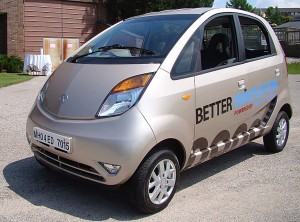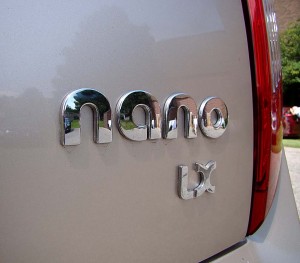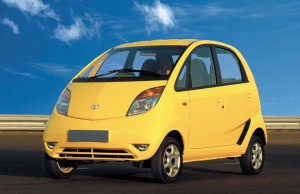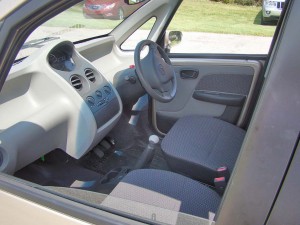The little four-seater proves reasonably adept as we pull away from the Grand Traverse Resort. It’s not registered for U.S. roads, so we have to stick to the sprawling complex’s service roads, but they’re long and quick enough to give us a sense of what to expect from one of the most well-publicized cars in the world.
The Tata Nano is not only the cheapest car on the road, but also one of the smallest. At 122 inches, nose-to-tail, it’s barely a foot longer than the Smart fortwo – even with its two back seats. And, at just 1,500 pounds, it weighs about 300 pounds less than the Franco-German Smart.
That helps the little Nano make do with a miniscule 624-cc (0.6 liter) two-cylinder engine making 35 horsepower. Whether it can take the fortwo in a drag race is uncertain, though the Nano certainly won’t leave a patch of rubber. But rated at 56 mpg – with a 4-gallon gas tank giving it a theoretical range of 224 miles – one might forgive its less-than-stellar performance.
At least the Nano appeared to have enough power to keep up with stop-and-go traffic, though the small engine is rather coarse and there’s a lot of noise from the tires and engine.
Tata Technologies, the engineering sibling to India’s Tata Motors, has been taking a version of the Nano on a tour of the U.S. and, says Technologies’ Raymond Peters, the reception has been solid, especially on college campuses, where it could serve as a low-cost alternative to a bicycle or a third-hand used car.
At one recent event, “There were a lot of students there and almost every one of them said ‘Wow, I’d like one of these on campus,’” Peters said.
Certainly, it helps to know that the base price for a Nano is just $2,500 – or, more precisely, 116,000 rupees, which makes the Tata Nano the world’s lowest-priced car. It’s been a hit on the home market, but now the Indian automaker is looking to see if there are opportunities abroad. A European version is under development. But could the Indian 4-seater curry a market in the U.S., too?
That’s only one of the questions Tata officials need to answer. They also have to figure out whether U.S. buyers would be willing to accept the microcar’s limitations – and at what price.

Tata Technologies has been taking this version of the LX around the country - both to show its engineering prowess and to gauge the market potential.
The version Peters let us drive was a Nano LX, a definite step up, at $4,000, by Indian standards. The LX offers numerous improvements over the base Nano including fabric seats instead of vinyl, trim on the A and B pillars, heat and air conditioning, power front windows, power locks, 12-volt charging port and power-assist brakes.
To keep costs low, there are still some surprising omissions. For example, the tailgate, even on the LX, does not open. Power steering is not offered. There is no radio, although it is pre-wired for one, Peters said. The small cargo area is accessed by lowering the rear seatback. And the drivetrain resides under a panel in the storage compartment where it connects to the rear wheels.
The Nano also is mostly devoid of the ever-increasing amount of safety gear that is required of U.S. cars. There are no airbags although it does have a laminated windshield and seatbelts for four. It also lacks anti-lock brakes, traction control and stability control – all of which will soon be required on American vehicles.
While the Nano’s safety equipment is not up to U.S. standards, it’s a vast improvement over its main competitor in India, the motor scooter.
“There is a big gap between motorcycle and car costs and that’s where this fits,” Peters said.
Peters said it’s not unusual to see an entire family riding on a single motor scooter in India. In fact, he’s seen one picture with seven people hanging off one scooter. Compared to that, the Nano is a dramatic improvement in safety.
So what about that appeal in the U.S.?

By Indian standards, the LX is a near-luxury car for many buyers, but a U.S. version will need a lot more -- and will cost a lot more, as well.
“We could never do it for two and a half thousand dollars, but you could do it for five or six (thousand),” he said.
That would help bring the little car into compliance with emissions and safety standards, though such additions would probably boost an American Nano’s weight by several hundred pounds, and that, in turn, might require a bigger engine. Meanwhile, U.S. motorists might also demand an automatic gearbox rather than the four-speed manual currently offered to Nano buyers.
In other words, an American edition would require significant updates and upgrades that might result in a very different car than the Nano on the road today. Whether that revised vehicle would maintain its appeal is a question that Tata has yet to answer to its own satisfaction.



There was a long time when the vehicle with the most sales in the world was the 36/40hp VW Beetle. The VW L1 is supposed to go into product for 2013. That will be getting about 170MPG. It is a very aerodynamic tandem hybrid design that runs an 800CC engine.
http://en.wikipedia.org/wiki/Volkswagen_L1#2009_Model
I would be surprised if these minicars were popular because from my experience most folks,
men at least, love big tatas.